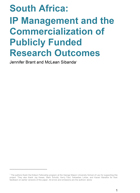Management of Academic Assets for Technology Transfer
What are academic assets?
Academic assets are defined as tangible or intangible resources that may be owned or controlled by an institution, managed and used in collaboration with another party to create public and/or economic value. There is a wide range of classifications of academic assets, but in a more general sense they can be divided into intellectual assets and non-intellectual assets.

Intellectual assets
- Intellectual property (created, identifiable and protectable by IP laws, such as patents, trademarks, industrial design, copyrights, etc.);
- Knowledge assets (protectable and identifiable by contract, commercial or competition law - such as trade secrets, knowledge, know how, expertise, etc.).
Non-intellectual assets
- Collections (libraries, etc.);
- Research infrastructure & capacity (laboratories, equipment and skilled people, etc.);
- Financial assets (spin-off companies, private fund managers, etc.);
- Operational assets (TTOs, KTOs, clinical trial officers, etc.);
- Strategic assets (reputation, access to patients, entrepreneurial culture, etc.).
Mapping of Intellectual Assets
Universities and research institutions often own or control different types of “academic assets” that are potentially very useful and powerful resources for initiating collaborations with other research institutions, attracting industry partners or providing useful services to public sector and society. Often these institutions are not fully aware of the existence and potential value of the assets under their control.
WIPO has created a simple tool for mapping academic assets , intellectual and non-intellectual, that provides an overview of most conceivable assets that an academic institution may have, as well an overview of a variety of methods, actions and pathways for utilization of academic assets. The tool shows that strategic use of even non-intellectual assets can lead to very dynamic scientific or business collaborations that turn new inventions and IP into innovative products and services in the marketplace.
IPR Management in Academic Institutions
IP is not an asset by virtue of its mere existence, as the number of patents is not a measure of an organization's innovation potential. Strategic IPR management by qualified professionals is needed to enable the protected invention to generate income and other benefits at the end of the technology transfer and IP commercialization process.
The management of IPR is not a linear process, but it may be considered as a set of strategic processes that includes the following steps:
- Identifying potential assets created or acquired by the organization – invention, new technology, formula, code;
- Evaluation of the technical, legal and market advantages of the potential asset;
- Decision making on the available forms of protection , including registered protection (e.g. patents, trademarks, registered designs) and/or unregistered protection (e.g. trade secrets, copyright, circuit layout, database rights);
- Determining marketing and technology transfer strategy - whether IP assets will be used internally, commercialized by the organization - assignment or licensing, transferred to a third party or spin-off, or offered to the public for free;
- Identification of the best partners - in accordance with the business goal and socially responsible policy of the organization.
IPR management in academic institutions includes not only the actions necessary to transfer technology from inventors to public and private users, but also the necessary steps before the actual transfer (research management or "technology intelligence") and afterwards (technology portfolio management, i.e. auditing, patent prosecution, quality assurance, contract management after signing, human resource management, etc.). As such, IPR management is one of the important prerequisites for a successful technology transfer and sustainability of the impact of research outcomes on the society.
The legal framework for IPR management policies in academic institutions has four levels: international, national, institutional and professional associations-related levels. Moreover, due to complexity of IPR management process in academic institutions, clear IP management principles and guidelines are necessary to ensure the most effective outcome.

